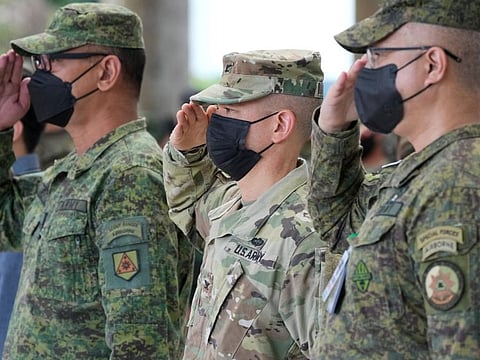US, Filipino forces start war drills
Exercises to include live-fire manoeuvres, aircraft assaults and beach landings

Manila: Thousands of American and Filipino forces began on Monday one of their largest combat exercises in years that will include live-fire manoeuvres, aircraft assaults, urban warfare and beach landings in a showcase of US firepower in the northern Philippines.
The annual exercises, called Balikatan - Tagalog for shoulder-to-shoulder - will run up to April 8 with nearly 9,000 navy, marines, air force and army troops, including 5,100 American military personnel, to strengthen the longtime treaty allies’ “capabilities and readiness for real-world challenges,” US and Philippine military officials said.
China will likely frown on the war drills given their relative proximity to Taiwan, which it claims as Chinese territory, but organizers said the exercises don’t regard any particular country as a target.
“The US military and Armed Forces of the Philippines will train together to expand and advance shared tactics, techniques, and procedures that strengthen our response capabilities and readiness for real-world challenges,” said Maj. Gen. Jay Bargeron, the US 3rd Marine division’s commanding general. “Our alliance remains a key source of strength and stability in the Indo-Pacific region.”
First staged in 1991, the Balikatan exercises are anchored on the 1951 Mutual Defense Treaty, which commits the United States and the Philippines to come to the aid of the other in case of an attack. The allies aim to be strong and seamlessly braced for any security contingency as a deterrence against war. “It’s for mutual defence, never for offense,” Philippine military spokesman Col. Ramon Zagala said.
The treaty alliance “declares formally our sense of unity and determination to mutually defend against external armed attack, so that no potential aggressor could be under the impression that either of them stands alone,” Zagala said.
But the governor of northern Cagayan province, where amphibious landings with limited live-fire manoeuvres were scheduled to be held in the coastal town of Claveria this week, has opposed any joint exercise utilising gunfire, fearing it could antagonize China.
“The military consulted and asked me, but I said I cannot allow any live-fire exercise. Any exercise is OK, but live-fire,” Cagayan Governor Manuel Mamba said by telephone. “We have to engage China, but not in a war, because I know Taiwan is a powder keg.”
China, along with the US and Taiwan, have expressed interest in investing in Cagayan, which has an underdeveloped agriculture and related industries, Mamba said, adding “I’m not pro-China, I’m pro-Cagayan.”
A Philippine military official said the beach landing exercises would proceed in Claveria without any live-fire training, which will be held instead at Crow Valley, an aircraft gunnery range in Tarlac province further south of Cagayan.
The combat exercises in the northern Philippines are being held amid heightened tensions between Taiwan and China. But Zagala said most of the military manoeuvres have been planned a year ago and did not consider the recurring tensions in the Taiwan Strait.
Maj. Kurt Stahl of the third US Marine division said that while most combat exercises and humanitarian projects would take place in the country’s north, some manoeuvres will be staged on the western island province of Palawan, along with an air defence exercise featuring US and Philippine fighter aircraft around the western side of Luzon.
That region faces the disputed South China Sea, where China’s increasingly assertive actions, including the building of missile-protected island bases to reinforce its vast territorial claims, have sparked protests from rival claimants like the Philippines and Vietnam, along with condemnation from the US and its Western and Asian allies.
The large-scale exercises reflect how outgoing President Rodrigo Duterte has walked back on his earlier threat to restrict US military activities in the Philippines. He has nurtured closer ties with China and Russia while often criticising US security policies.
In July last year, Duterte reversed his termination of a key defence pact with Washington that allows large-scale combat exercises between US and Philippine forces like the Balikatan after the US provided millions of doses of coronavirus vaccine that he had publicly demanded.
President Joe Biden has said America’s vaccines were being donated to poorer countries at the time to save lives and “don’t include pressure for favours or potential concessions.”
Sign up for the Daily Briefing
Get the latest news and updates straight to your inbox



